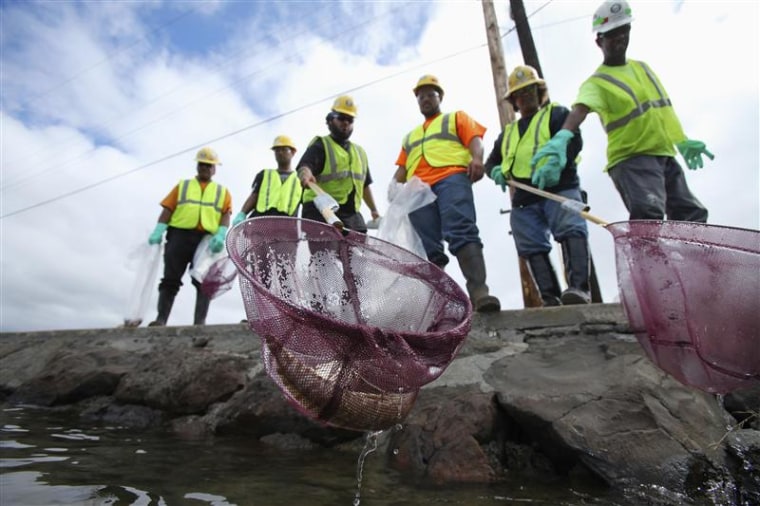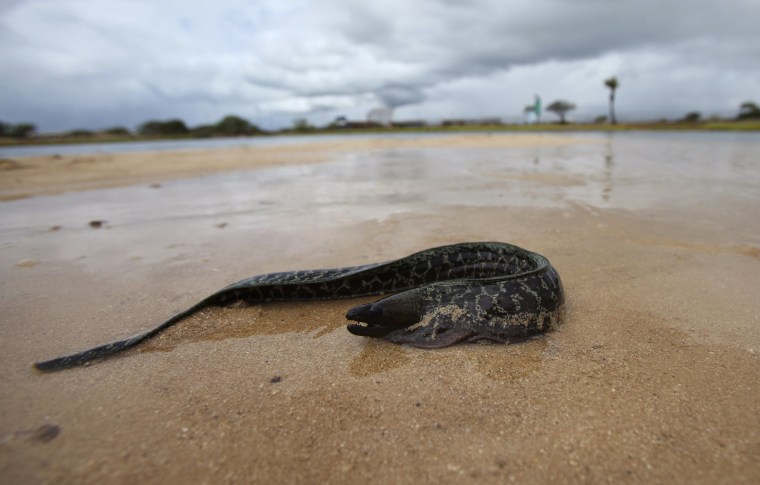
Over 200,000 gallons of thick molasses poured into the Honolulu harbor this week, leaving behind a drifting brown plume and a lot of dead fish. The spill is in many ways unlike other chemical leaks that response crews have dealt with, and researchers say it will take a combination of ocean currents, bacterial digestion — and maybe even some deep-sea vacuuming to mop up the mess.
The sweet sludge beloved by bakers isn't a toxin, of course, but the volume of it that has entered the sheltered harbor is expected to throw a delicate ecosystem off balance. The first stage of that domino effect is already being felt: Crews from the Department of Health have spent whole days lifting hundreds of dead fish out of the water. As one diver told NBC's Honolulu affiliate KHNL: "Everything is dead."
The thing is, "molasses and sea water is a pretty unusual combination," Paul Kemp, associate director of the Center for Microbial Oceanography in Hawaii, told NBC News.
While ocean spill cleanups often involve oil, molasses as a substance is very different. For starters, oil floats, but molasses sinks. To Kemp, this spill more closely resembles the spillage of raw sewage into the ocean. "It's relatively fresh material, it's organic-rich, it's heavy," he said. "All of those things would be somewhat comparable."
Molasses in seawater "can form a soup that clogs the gills of sealife and may otherwise smother plants and animals living on the seafloor," Mark Hixon, professor of marine biology at the University of Hawaii wrote to NBC News in an email.
Eventually, the molasses will leave the harbor naturally, dissolved in water and flushed out by the currents. But estimating how long that will take is difficult, and depends on the movement of the currents, experts told NBC News.

While everyone waits for the molasses to dissolve out, though, marine biologists will be bracing for the secondary fallout. Its sugary content becomes an unexpected bonanza for a whole range of marine microbes. Researchers like Hixon expect it will trigger a feeding frenzy among bacteria that live in the ocean, which will seize the opportunity to multiply swiftly.
Though the bacteria will be helpfully breaking down the molasses, in doing so, they'll strip the oxygen from water, choking other sea life in the area. The extra nutrients could even trigger some harmful algal blooms, Hixon said.
So far, Matson Navigation — which operates the pipeline that inadvertently spewed the 233,000 gallons of molasses into Honolulu Harbor — and the Hawaii State Department of Health, which is leading the cleanup, are betting on natural flushing of the harbor by ocean currents to drag the slime out to sea. The department said in a press release that it would "monitor the plume and judge how long it will take to flush out to sea."
But if the fish die-off starts to get dire, there may be other options.
Nancy Kinner, an oil cleanup expert and professor of civil engineer at the University of New Hampshire told NBC News that the molasses is similar to some thick crude oils, which have spilled and sunk in the open ocean.
Prototypes of underwater vacuums that can suck up submerged oil have been tested by the Coast Guard research crews: "They're designed to vacuum up the oil, to remove it from the bottom," she said. "Something like that could be deployed but you'd need to get it out there and mobilize it."
Kinner is conducting research on thick crude and bitumen cleanups in her lab. And guess what she's been using in the lab as a stand-in for the heavy oil. Give up? Molasses.
Nidhi Subbaraman writes about science and technology. You can follow her on Facebook, Twitter and Google+.